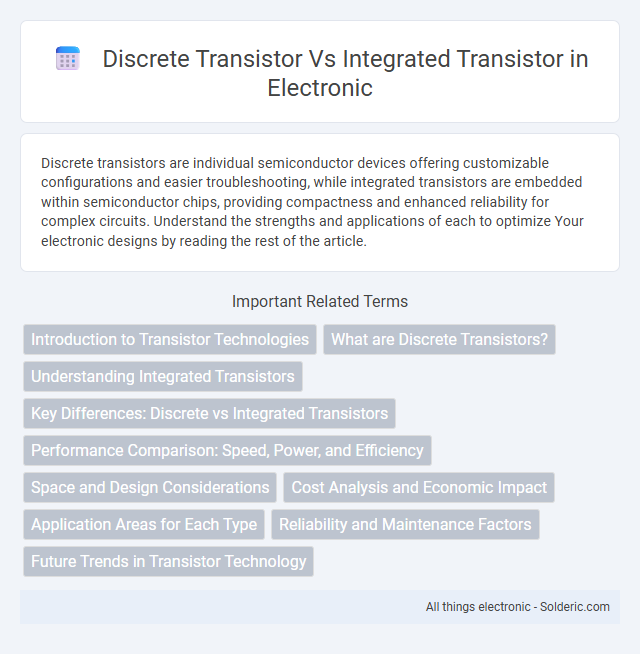Discrete transistors are individual semiconductor devices offering customizable configurations and easier troubleshooting, while integrated transistors are embedded within semiconductor chips, providing compactness and enhanced reliability for complex circuits. Understand the strengths and applications of each to optimize Your electronic designs by reading the rest of the article.
Comparison Table
| Feature | Discrete Transistor | Integrated Transistor |
|---|---|---|
| Definition | Individual transistor component. | Multiple transistors fabricated on a single chip. |
| Size | Larger, standalone device. | Compact, miniaturized on IC. |
| Cost | Higher per unit, due to separate packaging. | Lower cost per transistor in bulk. |
| Performance | Often better heat dissipation and power handling. | Optimized for high-density circuits, but limited by chip constraints. |
| Applications | Power amplifiers, switching circuits requiring high power. | Portable electronics, microprocessors, digital circuits. |
| Reliability | Ease of replacement and failure isolation. | Higher integration reduces assembly errors but harder to repair. |
| Manufacturing | Separate fabrication and packaging processes. | Batch fabrication using semiconductor IC processes. |
Introduction to Transistor Technologies
Discrete transistor technology involves individual semiconductor devices packaged separately, offering high flexibility in circuit design and easier heat dissipation. Integrated transistor technology incorporates multiple transistors and other components into a single chip, enabling compact, high-speed, and cost-effective electronic circuits. The choice between discrete and integrated transistors depends on application requirements such as power handling, frequency response, and manufacturing scale.
What are Discrete Transistors?
Discrete transistors are individual semiconductor devices used to amplify or switch electronic signals in circuits, typically packaged in a single component with three leads: emitter, base, and collector. They provide flexibility in circuit design by allowing precise control over electrical characteristics such as current gain and switching speed. Discrete transistors are commonly used in power amplification, signal processing, and discrete electronic modules where customization and robustness are essential.
Understanding Integrated Transistors
Integrated transistors are fabricated within semiconductor chips alongside other components, enabling compact and efficient circuit designs compared to discrete transistors, which are standalone devices. These integrated transistors benefit from advanced lithography and doping techniques, resulting in enhanced performance, reduced parasitic elements, and lower power consumption. Understanding integrated transistors involves recognizing their role in complex ICs, where millions of transistors operate together to achieve high-speed processing and miniaturization in modern electronics.
Key Differences: Discrete vs Integrated Transistors
Discrete transistors are individual semiconductor devices packaged separately, offering flexibility in circuit design and easier replacement, while integrated transistors are embedded within ICs to save space and improve performance by reducing parasitic elements. Discrete transistors generally handle higher power and voltage levels, whereas integrated transistors are optimized for compactness, lower power consumption, and mass production within complex electronic circuits. The key differences lie in packaging, power handling capabilities, and integration level, influencing their application in standalone components versus densely packed integrated circuits.
Performance Comparison: Speed, Power, and Efficiency
Discrete transistors, typically optimized for individual high-performance applications, offer faster switching speeds and higher current handling capabilities compared to integrated transistors, which combine multiple components on a single chip. Integrated transistors excel in power efficiency due to minimization of parasitic elements and reduced interconnect capacitance, resulting in lower overall power consumption in complex circuits. Efficiency in integrated transistors is enhanced by advanced fabrication techniques, while discrete transistors remain preferred for applications demanding maximum speed and power robustness.
Space and Design Considerations
Discrete transistors require more physical space on a circuit board due to their individual packaging, which can limit design flexibility in compact electronic devices. Integrated transistors, built within semiconductor chips, optimize space by combining multiple transistors into a single, compact unit, enabling more complex circuit designs and higher component density. Your choice between discrete and integrated transistors will impact both the overall layout and scalability of your electronic system.
Cost Analysis and Economic Impact
Discrete transistors generally incur higher costs per unit due to individual packaging and assembly requirements, while integrated transistors offer significant cost savings through mass production and miniaturization. Your choice impacts the overall economic efficiency of electronic design, with integrated transistors reducing material expenses and improving device reliability. Economies of scale in integrated transistor manufacturing drive down prices, making them the preferred option for cost-sensitive, high-volume applications.
Application Areas for Each Type
Discrete transistors are commonly used in high-power applications, such as audio amplifiers, power supplies, and RF transmitters, due to their superior heat dissipation and customization capabilities. Integrated transistors, found within IC chips, dominate in consumer electronics, microprocessors, and digital circuits where miniaturization and mass production drive efficiency and cost-effectiveness. Your choice depends on whether your project prioritizes individual component performance or compact, scalable integration.
Reliability and Maintenance Factors
Discrete transistors offer easier individual replacement, improving maintenance efficiency in circuits prone to component failure, while integrated transistors within ICs provide higher reliability due to consistent manufacturing processes and reduced interconnection issues. Integrated transistors benefit from encapsulation and protection against environmental factors, resulting in longer operational life and reduced maintenance frequency. However, troubleshooting discrete transistors is simpler because each component can be tested and replaced independently, contrasting with integrated transistor faults requiring entire IC replacement.
Future Trends in Transistor Technology
Future trends in transistor technology emphasize the shift from discrete transistors to highly integrated transistor arrays within semiconductor chips, enabling greater miniaturization and enhanced performance. Advances in materials like gallium nitride and silicon carbide are poised to improve switching speeds and thermal management in both discrete and integrated transistors. The rise of novel transistor architectures such as FinFETs and gate-all-around FETs in integrated circuits drives power efficiency and scalability essential for emerging applications like AI and 5G networks.
Discrete transistor vs Integrated transistor Infographic

 solderic.com
solderic.com